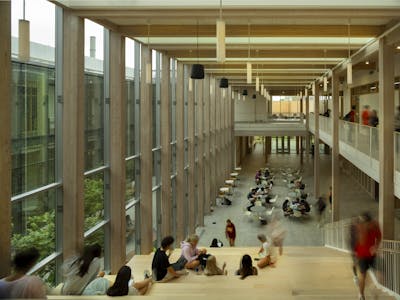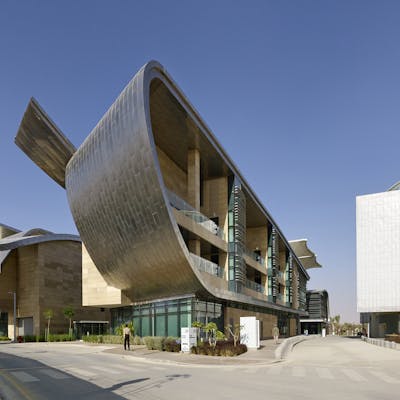
San Jacinto College Anderson-Ball Classroom Building
Collaborating with multiple teams to construct a new mass timber facility.
Project Facts
| Location | Pasadena, Texas |
| Owner | San Jacinto College |
| Size | 120,000 SF |
| Cost | $42 million |
| Status | Completed 2021 |
Overview
San Jacinto College’s newest project, a 120,000 square foot classroom building, is the largest instructional building in the U.S. constructed from mass timber. Walter P Moore knew the utilization of a mass timber structural system required a closer relationship between the design team, ownership, general contractor, and subcontractors—even more so than many typical structural systems.
Services
About the Project
Overview
The San Jacinto College Anderson-Ball Classroom Building is a diverse program of spaces and uses. It contains 60 typical classrooms, faculty offices, a large presentation hall, a lecture hall, a robotics laboratory, and a double-height grand lobby to welcome visitors. During the concept phase of design, the college engaged the design team and two general contractors to produce a cost comparison between a building constructed of mass timber and a comparable steel building.
One contractor concluded that the mass timber building would be 18% more expensive while the other concluded that it would be 0.5% less expensive. This exercise gave the college confidence that they could proceed with the mass timber structural system and keep the project within their budget.
Working with Mass Timber
Walter P Moore worked with multiple partners in the design and construction process, including the owner, architect, and mass timber provider to ensure that the connection between mass timber elements was detailed in such a way as to reduce potential maintenance issues, such as janitorial damage to wood column bases.
The mass timber framing, production, erection, and connections were provided by a sole source supplier selected from an interview process conducted by community college representatives, the general contractor, the architect, and the structural engineer. BIM coordination efforts between the general contractor, architect, subcontractors, and engineers began once the mass timber supplier was selected, giving the team a head start on discovering any construction issues and schedule.
Construction
To get construction started, our team collaborated with the mass timber provider to ensure that the connections of the mass timber structural elements were fully understood and approved by all parties before arriving on-site. Then, we provided the general contractor with two schemes for wind-force resisting systems, one using steel brace and glulam brace frames and the other using cross-laminated shear walls. This exercise helped the team to choose the brace-frame option due to its lower cost, foundation implications, and flexibility it provided in the floor plan.
The contractor, architect, and Walter P Moore team worked to determine the best fit possible between the new structural layout and the existing foundation layout. During construction, we worked closely with the general contractor to quickly resolve unforeseeable conditions in the existing foundation system. We also collaborated with a vibration monitoring firm hired by the college to install vibration testing equipment in the building so that the vibration characteristics can be understood once the building is in use.
Key Features
Once the structural construction was underway, more mass-timber building components started inside, including in the lobby that also had a monumental stair made of glulam beams and a bridge spanning across the short length of the lobby at level 2 made of glulam beams on display. Additionally, cross-laminated timber floor panels, cross-laminated timber feature walls, and a walkway spanning the long distance of the lobby at level 2 suspended by steel rods from the mass timber structure at the lobby roof helped this welcome area stand out.
The third floor of the building contains office space and flexible workstation spaces, which require a different layout from the classroom spaces below. To address this change in program and wall layout, the building lateral system was modified on the third floor so that the steel braces could be configured differently than below.
Other key features of the new building are:
- A modern facade system that reflects the current aesthetic of the San Jacinto Community College campus while giving it a modern update
- A main enclosure system that consists of brick, metal panels, and large expanses of curtain wall
- Three exterior stairs that are partially enclosed by a decorative clay masonry system that has regularly located openings to match existing masonry screen walls at adjacent buildings
- A floor plate made of cross-laminated timber with an acoustic mat covered in a concrete topping layer
- Floors supported by glulam girders spanning in one direction only and framing into glulam columns
- A lateral system consisting of a combination of steel brace frames, and glulam brace frames
- A cross-laminated timber roof designed to accommodate total coverage with solar panel arrays
- Cross-laminated timber walls around the building stairwells and elevator shaft to meet fire ratings
Mass Timber on Display
The new classroom building is a sign of San Jacinto Community College’s commitment to mass timber. The college has used this building as a platform to promote the use of mass timber in the Gulf Coast region by hosting a series of mass timber conferences.
The first Texas Gulf Coast Mass Timber Conference was held at the college campus over two days in February 2020. Presenters included the design architect, American Wood Council, Woodworks, the general contractor for the building, a fire-safety consultant, and a general contractor with previous experience building mass timber buildings. The second Texas Gulf Coast Mass Timber Conference was held in April 2021 and included tours of the building.








